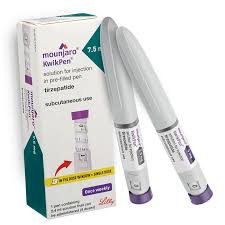Introduction
mounjaro pen for sale; In recent years, a new prescription injectable called Mounjaro (active ingredient tirzepatide) has gained attention for its dual role in helping with type 2 diabetes management and weight loss. If you’re hearing about it for the first time—or are considering it as a therapy option—this guide covers what it is, how it works, benefits, risks, and practical tips.
Disclaimer: This content is for informational purposes only and does not replace medical advice. Always consult your healthcare provider before starting or changing any treatment.
⸻
What Is Mounjaro (Tirzepatide)?
• Brand / generic name: Mounjaro is the brand name; the drug substance is tirzepatide.
• Drug class: It acts as a dual agonist for two hormones — GLP-1 (glucagon-like peptide 1) and GIP (glucose-dependent insulinotropic polypeptide).
• FDA / regulatory status: Originally approved for type 2 diabetes, it is also being used or studied for weight management in patients with obesity or overweight.
• Mechanism of action: Mounjaro works by increasing insulin release (when blood sugar is high), reducing glucagon secretion, slowing gastric emptying, and reducing appetite. Its dual targeting (GLP-1 + GIP) is believed to enhance weight loss effects compared to GLP-1–only agents.
⸻
Indications: When and Why It’s Used
- Type 2 Diabetes
Mounjaro is used as an adjunct to diet and exercise to improve glycemic control in adults with type 2 diabetes. 
- Weight Loss / Obesity (Emerging Use)
Many patients using Mounjaro report significant weight reduction. Although not all regulatory agencies have officially approved it solely for weight loss, clinical interest is high, and in some jurisdictions, it is being prescribed off-label or under specific obesity management guidelines. 
⸻
Dosage & Administration
Starting Dose & Escalation
• The recommended starting dose is 2.5 mg once weekly, injected subcutaneously. 
• After an initial period, the dose may be increased gradually (per prescriber’s directions) to reduce side effects and optimize efficacy. 
How to Inject Mounjaro
Here’s a step-by-step of how typical usage works:
1. Choose injection site: The abdomen (at least 2 inches away from the belly button), the upper thigh, or the back of the upper arm (if another person is giving the injection) are common sites. 
2. Prepare the pen & dose: Use a prefilled pen (KwikPen). Make sure the dose setting is correct as prescribed. 
3. Inject subcutaneously (under the skin): Insert the needle at a 90° angle (or 45° if you are very lean) and press the injection button until the dose is delivered. Hold for a few seconds to ensure full delivery. 
4. Rotate injection sites: Avoid using the same spot repeatedly. Alternate within the approved areas. 
5. Disposal: Dispose of the pen or needle safely according to local guidelines after use. 
For a visual demonstration, see the video “Mounjaro: How to inject using the pre-filled pen” on Drugs.com. 
⸻



Benefits (What’s Good About Mounjaro)
- Dual Hormone Pathway = Stronger Effects
Because Mounjaro targets both GLP-1 and GIP pathways, many patients experience greater weight loss and better glycemic control compared to some older agents. 
- Weight Loss Results
In clinical and observational data, many users lose 10-20% (or more) of baseline body weight when used properly along with diet/exercise. 
- Improved Blood Sugar / HbA1c
Because it helps the insulin–glucagon system, many patients see reduced A1C levels and improved glycemic control. 
- Appetite Suppression & Satiety
Patients often report lower appetite, reduced cravings, and feeling fuller for longer — which supports calorie reduction.
- Potential Cardiovascular & Metabolic Benefits
Some early studies suggest positive effects on cholesterol, blood pressure, and markers of cardiovascular risk, but long-term data are still emerging.
⸻
Risks, Side Effects & Safety Considerations
Common Side Effects
• Nausea, vomiting, diarrhea, constipation, abdominal discomfort
• Reduced appetite
• Some patients may also experience injection site reactions
These tend to occur early in treatment and often diminish over time.
Serious Risks / Warnings
• Thyroid C-cell tumors / medullary thyroid carcinoma (MTC): Contraindicated in patients with personal or family history of MTC or MEN2 syndrome.
• Pancreatitis: There have been associations of GLP-1/GIP agonists with pancreatitis; monitor for symptoms (severe abdominal pain).
• Gallbladder disease, kidney injury, and hypoglycemia (especially when used with other glucose-lowering agents) must be considered.
• Gastrointestinal disorders: Because the drug slows gastric emptying, caution is needed in patients with gastroparesis.
Always consult a doctor about your medical history.
“Golden Dose” Warning
Some users try to extract an extra (fifth) dose from a pen after the labeled 4 uses. This is risky — the pen is no longer sterile, dosage may be inaccurate, and infection risk rises. Experts strongly discourage this practice. 
⸻
Practical Tips for Success
• Stick to a weekly schedule — choose a consistent day and time to reduce missed doses.
• Combine with diet and exercise — injections work best when paired with lifestyle changes.
• Hydration and small frequent meals — to manage GI side effects.
• Rotate injection sites to reduce local irritation.
• Monitor labs: regular blood sugar, kidney function, pancreatic enzymes as advised by your physician.
• Have realistic expectations: weight loss is gradual and individual.
Mounjaro (tirzepatide) represents a promising new option at the intersection of diabetes care and weight management. Its dual-hormone mechanism, strong weight loss potential, and glucose control benefits make it an interesting tool in modern medicine. However, it’s not risk-free, and optimal results depend on careful dosing, lifestyle changes, and close medical supervision.
If you’re considering Mounjaro, speak with an endocrinologist or relevant specialist. And if you’d like, I can help you craft a companion post like “How to start Mounjaro safely” or “Mounjaro vs Ozempic in 2025”.
